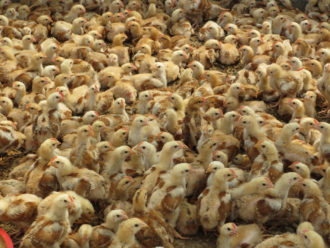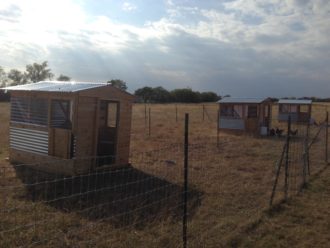COMMERCE, Texas – Research at Texas A&M University-Commerce has found that adding a safe, artificial light source to the coops of pasture-raised poultry increases egg laying in hens in the fall and winter – a time of the year when egg production in pasture poultry generally declines.
Graduate student Margaret Morgan said that the main purpose of the study is to discover the effects of a commercial-style lighting system on a pasture-style production system compared to traditional commercial-style and pasture-style production systems.
“Commercially raised hens are commonly kept indoors under artificial lighting for fourteen to sixteen hours per day. As pasture-raised hens do not have a controlled photoperiod, egg laying declines during times of the year when day length or photoperiod is short,” said Morgan. “It is hypothesized that egg-laying rates will increase in pasture-raised hens if artificial light is added to coops to mimic long days during periods of decreasing daylight."
In the Southern Sustainable Agriculture Research & Education (SSARE) Graduate Student Grant (GS14-138), “Use of Artificial Lighting to Increase Photoperiod Length for Pasture-Raised Laying Hens to Improve Egg Productivity and Quality,” Morgan compared three breeds (Cuckoo Marans, Easter Egg Hybrids, and Silkie pullets) in three management systems: commercial, pasture-raised without artificial lighting, and pasture-raised with artificial lighting. Under the commercial and pasture-raised with artificial lighting systems, the hens were exposed to 14 hours of artificial light. In the pasture-raised system, they were only exposed to natural daylight, which was about 10 hours a day.
In the results of the study, Morgan found that hens increased their egg laying under the commercial system and pasture-raised systems with artificial light.
That’s good news for producers interested in pasture-raised as a more sustainable means of poultry production compared to commercial management practices. In addition, Morgan found that the eggs of pasture-raised hens were larger and of higher quality than the eggs from commercial hens.
“Given the increase in egg quality measurements that pasture-raised eggs exhibit over commercial-style eggs, such as yolk color, albumen height, and egg weight, it is concluded that pasture-raised eggs can provide benefits to the producer and the consumer,” said Morgan. “It is also concluded that combining a pasture system with a commercial-style lighting regime, which results in greater egg deposition rate, contributes to a more desirable overall production system for the producer and the consumer.
The artificial lighting used was a combination of the Yeti Solar Light Passage Light, the Yeti Solar Light Passage Timer, and the Pullet Shut Automatic Coop Door. This particular system was chosen because of the included broad-spectrum LED light that came close to mimicking sunlight.
Morgan said that the artificial lighting system is economical for producers, costing about $40 to add to a chicken coop. The breakeven point is around the eighth week of production for producers with roughly 10 hens in coop.
“Pasture-raised eggs easily sell for $6 per dozen in northeast Texas during the fall and winter at local farmers markets. Therefore, for this economic analysis the value of one egg is estimated at 50 cents,” said Morgan. “The weekly egg laying rate of pasture-raised hens without artificial lighting was 0.25 eggs per hen, and the weekly egg laying rate of pasture-raised hens with artificial lighting was 1.125 eggs per hen, resulting in 0.875 more eggs per hen per week. From October through March, when hen productivity is generally lower, this added light could result in $65 greater gross income for a producer.”
Providing supplemental lighting to pasture-raised laying hens is a simple practice for poultry producers, and has great potential to increase both quantity and quality of egg products for producers seeking sustainable alternatives for their hen production systems.
Jackie Wahrmund, assistant professor of animal science at Texas A&M University-Commerce was also part of the project.
Published by the Southern Region of the Sustainable Agriculture Research and Education (SARE) program. Funded by the USDA National Institute of Food and Agriculture (NIFA), Southern SARE operates under cooperative agreements with the University of Georgia, Fort Valley State University, and the Kerr Center for Sustainable Agriculture to offer competitive grants to advance sustainable agriculture in America's Southern region. This material is based upon work that is supported by the National Institute of Food and Agriculture, U.S. Department of Agriculture, through Southern Sustainable Agriculture Research and Education, under sub-award number: GS14-138. USDA is an equal opportunity employer and service provider. Any opinions, findings, conclusions, or recommendations expressed in this publication are those of the author(s) and do not necessarily reflect the view of the U.S. Department of Agriculture.

